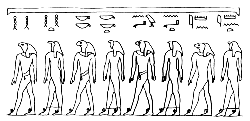
Designation of the eight gods of Hermopolis, four male and four female, personifying the four primeval elements in pairs. Their names convey the nothingness and emptiness that existed before creation: Nun and Naunet (the primeval ocean), Kek and Kauket (the primeval darkness), Heh and Hauhet (the endlessness of space) and Amun and Amaunet (what is hidden).They are also considered to be the parents of the sun god, the child which appeared at creation on an island which rose out of the primeval state. The Ogdoad tradition mainly dates from the Graeco-Roman Period, but the gods were already known in the Old Kingdom. At that time, for example, Khmun ('City of the Eight') was already the name of what later became Hermopolis. The modern name of the place (el-Ashmunein) is derived from this name. In order to ensure the primacy of the Hermopolitan creation myth over those from other important cities, we are told that the eight gods were born in Thebes, a link possibly due to the influence of the god Amun worshipped there, and travelled throughout Egypt. On completion of their work of creation they returned to Thebes. Djeme, near Medinet Habu, the place where they were said to be buried, was an important cult centre. Illustrations usually show the male members of the Ogdoad with frog heads and the female members with snake heads. There are also representations of them as humans, with the skin of the male members usually blue. Occasionally the gods are represented as baboons greeting the morning sun, referring to the creation myth in which the sun rises on the primeval island.